Teachers all over Arizona held the largest strike in the state’s history last week, shutting down school districts all over the state. The strike culminated in a budget passing the legislature Thursday, May 3, that includes $644 million in funding to increase teacher pay by 20 percent over the next four school years.
Verde Valley schools joined in, though they for the most part did not stay open for the full six days of strike, like some school districts in other parts of Arizona did.
Teachers said they are pleased at the success of the Red for Ed movement, but they also say that much more is still needed. The 20 percent raise is similar to the one that Gov. Doug Ducey proposed in response to activism before the strike. But teachers point as well to an additional $371 million allocated over the next five years for further flexible expenditures on education. Teachers walked out in response to the governor’s initial deal because it did not provide for other school support staff and further needs of school districts.
“I would consider this a success, absolutely,” said Jason Teague, a Mingus Union High School art teacher who had been organizing Cottonwood teachers during the strike. “It’s not everything we wanted, but it’s way larger of a deal than what the governor was offering three weeks ago.”
“The Red for Ed movement got the most we could for our students from this legislature,” said Brenda Lewis, a Cottonwood Elementary School fourthgrade teacher who had become a de facto leader during the walkouts.
Not all teachers had such a rosy outlook. Chris Furry, an English and social studies teacher at Mingus, said he felt the movement was not a success.
“No. What was passed by the legislature was what was proposed before the protests,” Furry said. “The Red for Ed movement, based on what the legislature did, has no choice but to become a movement for candidates and ballot measures.”
To some teachers, the Red for Ed movement and the strikes last week are viewed as just a beginning, hopefully leading to more lasting changes in the future.
“What I’m seeing as the next battleground is making sure there is protected revenue for education going forward,” Teague said. “They’re banking on increased growth in the Arizona economy. That could happen or not happen. If it doesn’t, then we’re right back here. Having a protected revenue scheme is the biggest thing we need to be focusing on.”
Teachers said they hope the movement has at least forestalled the need for a repeat strike soon. Lewis pointed to the way that the movement has placed national attention on the plight of Arizona teachers, meaning that education will remain a priority in future budgets. But for teachers, the next step may depend on the actions of the state government.
“If they continue to support education the way they’re saying they will, then I don’t see this happening again,” Teague said. “But if they reverse direction, who knows what could happen.”
Jon Hecht can be reached at 282-7795 or email jhecht@larsonnewspapers.com



